-
ARTÍCULO ORIGINAL18/10/2022
Humanized childbirth: the values of health professionals in daily obstetric care
Revista Brasileira de Enfermagem. 2022;75(2):e20210052
Resumen
ARTÍCULO ORIGINALHumanized childbirth: the values of health professionals in daily obstetric care
Revista Brasileira de Enfermagem. 2022;75(2):e20210052
DOI 10.1590/0034-7167-2021-0052
Visualizações0Ver maisABSTRACT
Objective:
To understand health professionals’ values in the process of thinking and feeling about obstetric care, based on their experienced needs in the care process.
Methods:
Phenomenological study based on the Schelerian framework, with 48 health professionals from four maternity hospitals within the Metropolitan Region II of the state of Rio de Janeiro. Data collection was done through a phenomenological interview; and the analysis, with the Ricoeurian methodological framework.
Results:
The vital value was signified in care centered on physiological processes, for an individualized and safe monitoring. The ethical value was signified in the attitudes that provide women with autonomy in their way of giving birth, and recognize dialogue as a process of sympathy, affection, and bonding.
Conclusion:
The resignification of obstetric practice, articulated with public policies in the field of delivery and birth, supported by a vital ethical value, positively contributes to the humanization of care for women.
-
ARTÍCULO ORIGINAL18/10/2022
Methods for measuring venous peripherally inserted central catheters in newborns
Revista Brasileira de Enfermagem. 2022;75(2):e20210045
Resumen
ARTÍCULO ORIGINALMethods for measuring venous peripherally inserted central catheters in newborns
Revista Brasileira de Enfermagem. 2022;75(2):e20210045
DOI 10.1590/0034-7167-2021-0045
Visualizações0Ver maisABSTRACT
Objective:
to analyze the results of insertion procedures of Peripherally Inserted Central Catheters in newborns using two measurement methods.
Methods:
this is a randomized clinical trial, presenting descriptive and exploratory results of variables. It was held at a Neonatal Intensive Care Unit. Data were collected between September 2018 and 2019. The sample analyzed was 88 catheter insertion procedures, distributed in two groups. Study approved by an Institutional Review Board and obtained registration in the country and abroad. Descriptive analysis and logistic regression of data.
Results:
modified measurement obtained a significant difference for the central catheter tip location. Elective removals and adverse events were not significant between groups; however, poor positioning was related to adverse events.
Conclusions:
between the two methods analyzed, the modified measurement obtained better results in the proper catheter tip positioning and, consequently, less risk to patients.
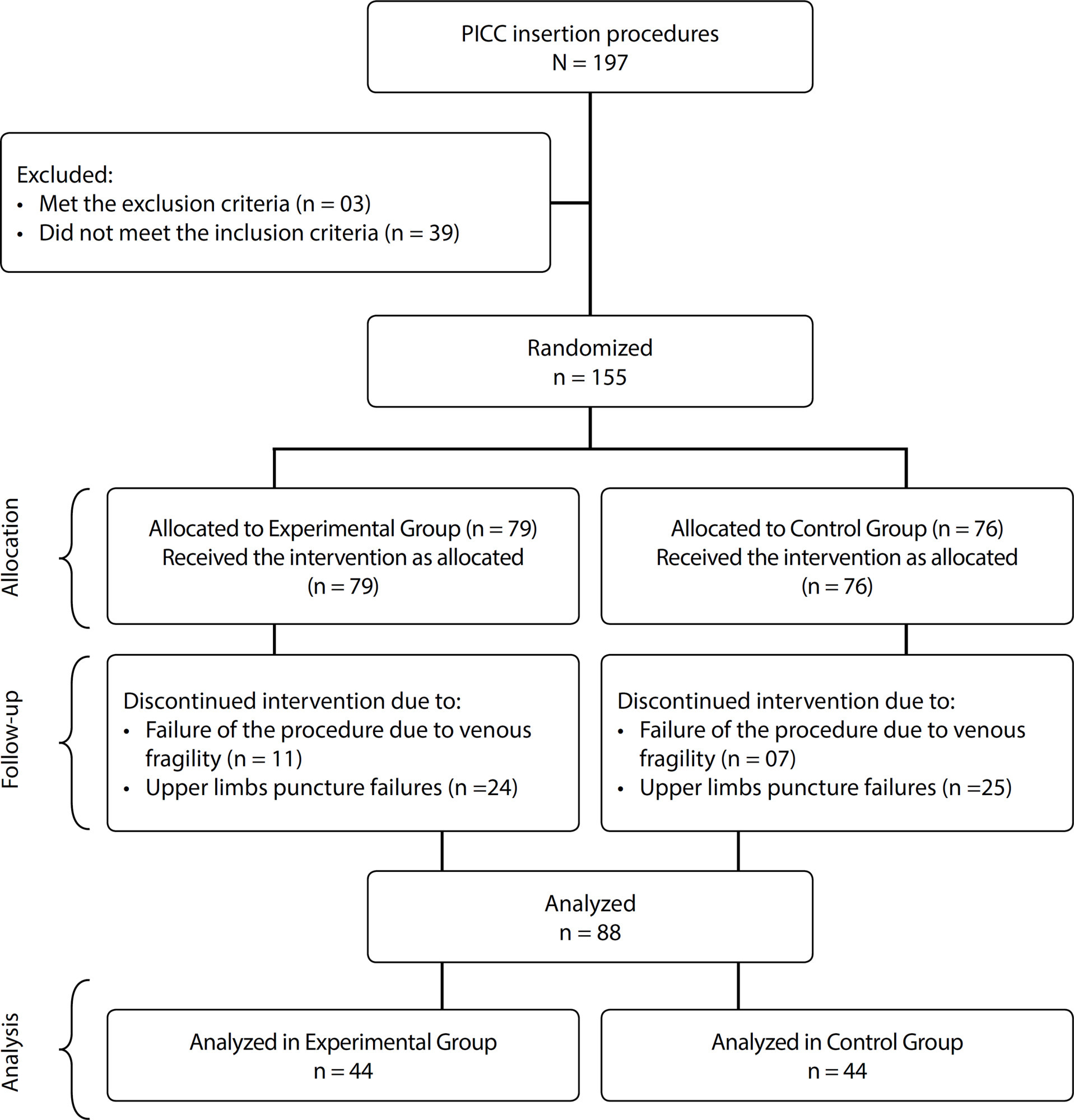
-
ARTÍCULO ORIGINAL18/10/2022
Clinical simulation as a Nursing Fundamentals teaching method: a quasi-experimental study
Revista Brasileira de Enfermagem. 2022;75(2):e20201155
Resumen
ARTÍCULO ORIGINALClinical simulation as a Nursing Fundamentals teaching method: a quasi-experimental study
Revista Brasileira de Enfermagem. 2022;75(2):e20201155
DOI 10.1590/0034-7167-2020-1155
Visualizações0Ver maisABSTRACT
Objectives:
to evaluate students’ knowledge gain after the implementation of clinical simulation in Nursing Fundamentals disciplines.
Methods:
a quasi-experimental intervention was carried out with 60 students, distributed in comparison and intervention groups, who underwent traditional teaching and traditional teaching associated with simulated teaching, respectively. Pre-test and post-test instruments were applied to both groups.
Results:
after analyzing the students’ performance through the applied instruments, both groups had a cognitive evolution along with the taught content, however, when compared, the intervention group obtained a higher knowledge gain than the comparison group (p = 0.016), demonstrating progressive and increasing improvement with the use of the methodology.
Conclusions:
simulated teaching significantly helps students in gaining technical-cognitive knowledge. Therefore, it is recommended to adhere to the use of this methodology for teaching Nursing Fundamentals.
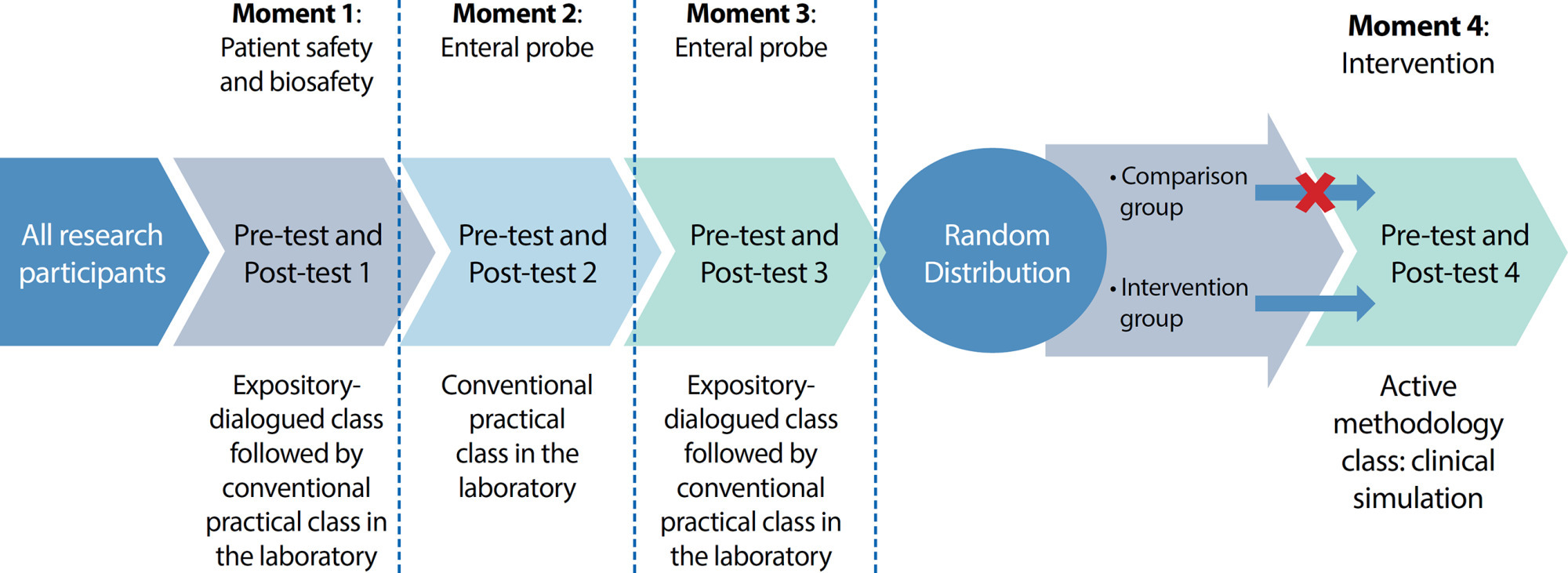
-
REFLEXIÓN18/10/2022
The act of playing as a signifier for the application of the dramatic Therapeutic Toy performed by the nurse: theoretical reflection
Revista Brasileira de Enfermagem. 2022;75(2):e20210062
Resumen
REFLEXIÓNThe act of playing as a signifier for the application of the dramatic Therapeutic Toy performed by the nurse: theoretical reflection
Revista Brasileira de Enfermagem. 2022;75(2):e20210062
DOI 10.1590/0034-7167-2021-0062
Visualizações0Ver maisABSTRACT
Objective:
To reflect on the possible contributions of the act of playing as a signifier in the use of dramatic Therapeutic Toy performed by the nurse.
Methods:
Theoretical-reflexive study, based on three moments: The language of the unconscious that emerges as a signifier when playing; How the dramatic Therapeutic Toy is used by the nurse; and the act of playing as a signifier during the application of the dramatic Therapeutic Toy: contributions to nursing practice.
Results:
Through the intervention of the nurse in the sessions, the act of playing mediated by the dramatic Therapeutic Toy provides the child with the opportunity to elaborate on signifier elements that had not been meant by him.
Final considerations:
Through the dramatic Therapeutic Toy, the articulation of the child’s organism with his reality in the formation of the self constitutes an advance for the production of knowledge and nursing assistance to the child, enabling complete care and allowing the elaboration of their anxieties, which collaborates so that the child constitutes himself as a subject.
-
ARTÍCULO ORIGINAL18/10/2022
Information and communication technologies: interfaces the nursing work process
Revista Brasileira de Enfermagem. 2022;75(2):e20201280
Resumen
ARTÍCULO ORIGINALInformation and communication technologies: interfaces the nursing work process
Revista Brasileira de Enfermagem. 2022;75(2):e20201280
DOI 10.1590/0034-7167-2020-1280
Visualizações0Ver maisABSTRACT
Objectives:
to unveil the meanings that nurses attribute Information and Communication Technologies for the nursing work process
Methods:
qualitative research, theoretically and methodologically based on the Complexity Theory and on the Grounded Theory, respectively. Research with 19 participants, being 12 clinical nurses, and 7 resident nurses. Semi-structured interviews were used for data collection.
Results:
the results revealed the meanings that clinical nurses attribute to Information and Communication Technologies and, thus, the motivations and limitations for the use of these technologies, pointing out possibilities and strategies that impact the nursing work process, based on the interactions promoted by the official and non-official use of these resources.
Final Considerations:
the meanings that nurses attribute to Information and Communication Technologies are dependent on their ability to successfully employ those technologies and their importance to the work process developed by the professionals.
-
REFLEXIÓN18/10/2022
Improvement of Educational Products Validation form in professional postgraduate programs
Revista Brasileira de Enfermagem. 2022;75(2):e20210063
Resumen
REFLEXIÓNImprovement of Educational Products Validation form in professional postgraduate programs
Revista Brasileira de Enfermagem. 2022;75(2):e20210063
DOI 10.1590/0034-7167-2021-0063
Visualizações0Ver maisABSTRACT
Educational Product and Technical-Technological Product constitute a specificity of postgraduate programs in the professional modality, a product that must be carefully evaluated by the programs and recorded on platforms of evaluating bodies. In 2019, a working group from the teaching area was assembled to create a Validation Form for these products. Thus, this article aims to present a proposal for improving this Validation Form for Educational/Technical-Technological Products, based on reflections treated in scientific articles and scientific events from the area, focusing on the relevance and need for this type of evaluation in a standardized way. It is intended to collaborate with the improvement of the evaluation processes and procedures of Educational/Technical-Technological Products for the necessary accuracy, representativeness, and homogeneity, which will allow the real dimensioning of the contributions of these products. This involves not only training qualified professionals, but also transforming practices in the Sistema Único de Saúde (SUS) [Brazil’s Unified Health System], promoting advances in science and in its fields of application.
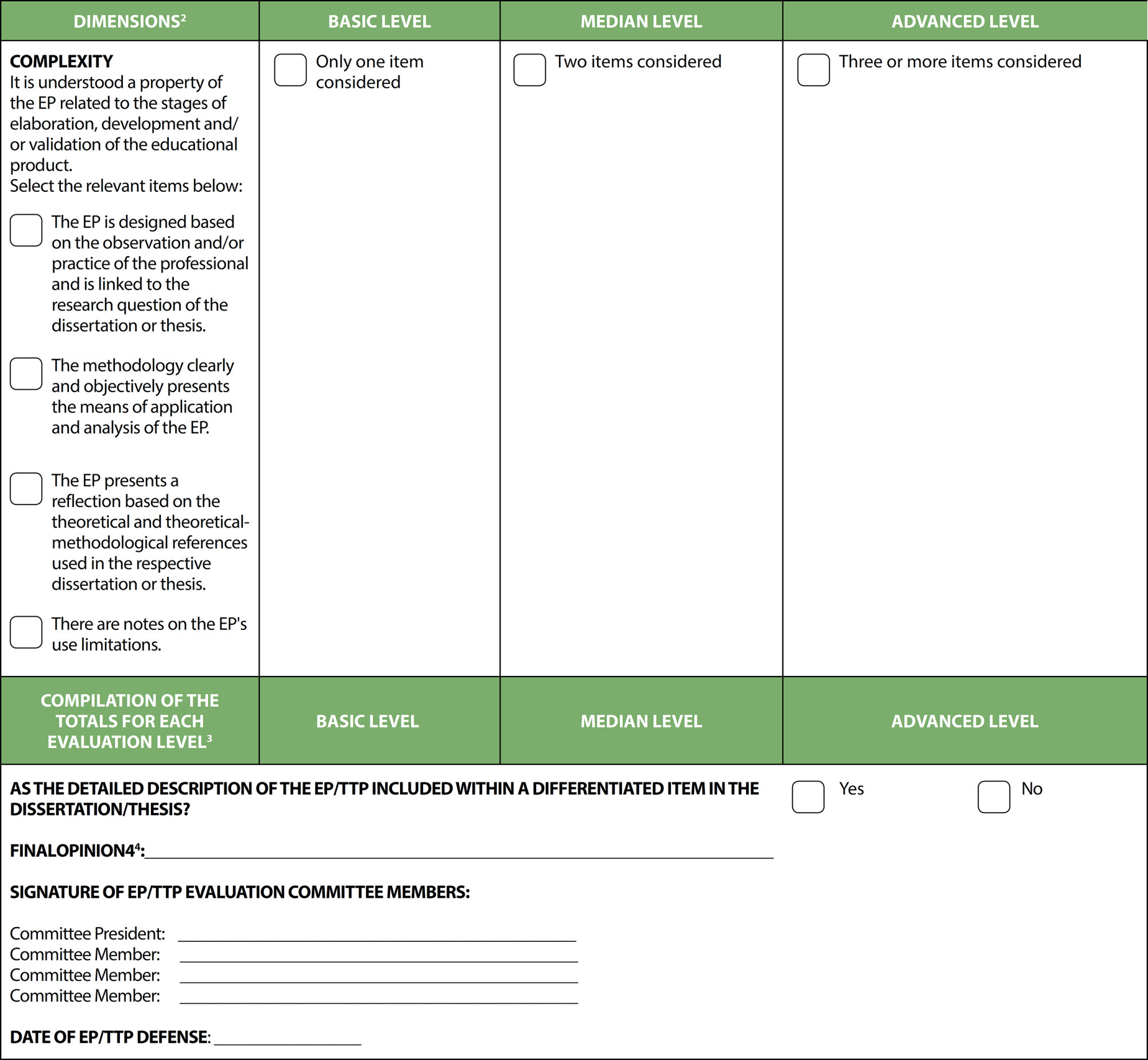
-
18/10/2022
COVID-19 and the nursing labor market: lessons learned by analogies between historical events
Revista Brasileira de Enfermagem. 2022;75(2):e20200328
Resumen
COVID-19 and the nursing labor market: lessons learned by analogies between historical events
Revista Brasileira de Enfermagem. 2022;75(2):e20200328
DOI 10.1590/0034-7167-2020-0328
Visualizações0INTRODUCTIONThe nursing labor market in Brazil is experiencing a paradox. There is, at the same time, both a strong pent-up demand for nursing workers and a large supply of unemployed nursing workers, in addition to workers who have left their profession to work in another field(). Major financial crises, such as the one that the […]Ver mais -
18/10/2022
Clinical progression of COVID-19 coinfection in people living with the human immunodeficiency virus: scoping review
Revista Brasileira de Enfermagem. 2022;75(2):e20201380
Resumen
Clinical progression of COVID-19 coinfection in people living with the human immunodeficiency virus: scoping review
Revista Brasileira de Enfermagem. 2022;75(2):e20201380
DOI 10.1590/0034-7167-2020-1380
Visualizações0Ver maisABSTRACT
Objectives:
to map the production of scientific knowledge on the clinical progression of COVID-19 coinfection in people living with the human immunodeficiency virus (HIV).
Methods:
scoping review, with search strategies in MEDLINE, Scopus, Embase, Web of Science, and LILACS. Dual independent data extraction and analysis of the material with similarity compilation and narrative synthesis.
Results:
sample consisted of 35 articles. Fever, cough, and dyspnea were the most prevalent signs/symptoms. Recurrent complications involved desaturation/worsening of oxygen desaturation and pneumonia. No standard pharmacological treatment was identified, and the main interventions involved the provision of supplemental oxygen and mechanical ventilation. The studies recommended preventive, care, and pharmacological practices.
Conclusions:
the clinical manifestations, complications, and treatments/assistance care for people coinfected with SARS CoV-2/HIV are similar to those of the general population. Coinfection, overall, does not infer a worse prognosis.
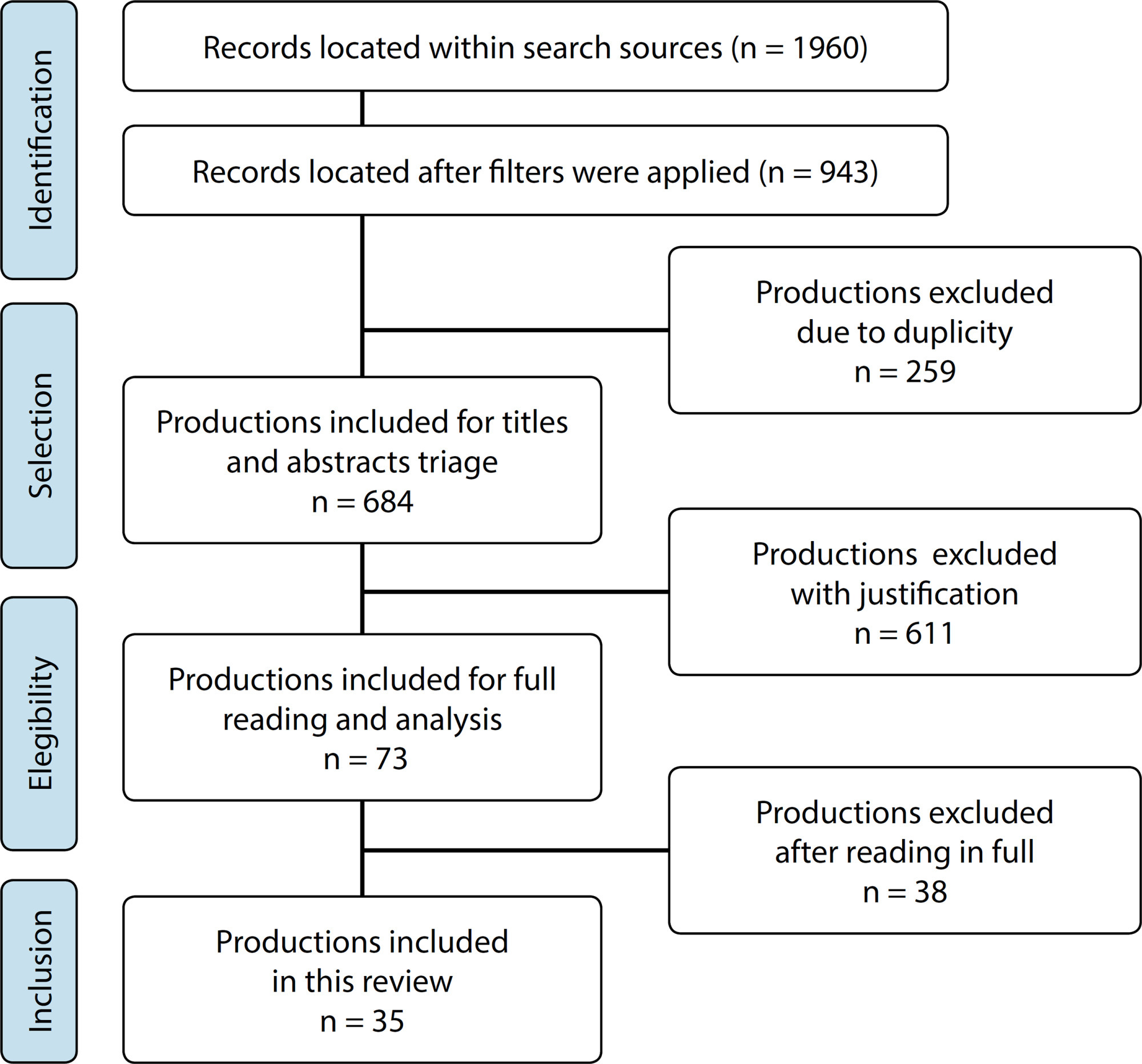
-
INFORME DE EXPERIENCIA01/01/2018
Clinical and epidemiological teaching of dengue through simulated practice
Revista Brasileira de Enfermagem. 2018;71(2):451-456
Resumen
INFORME DE EXPERIENCIAClinical and epidemiological teaching of dengue through simulated practice
Revista Brasileira de Enfermagem. 2018;71(2):451-456
DOI 10.1590/0034-7167-2016-0503
Visualizações2Ver maisABSTRACT
Objective:
to describe the experience of clinical teaching on dengue and the practice of epidemiological surveillance using problematization methodology.
Method:
report of experience on educational activity with undergraduate nursing students, held in March 2016, at a public university in the city of São Paulo, conceived in four stages: dialogic lecture, active search of Aedes aegypti, case study and simulation of nursing consultation to individuals with dengue.
Results:
The activity allowed to retrieve previous knowledge about the disease, respond to exercises that addressed different clinical situations and epidemiological surveillance, including in situ evaluation of possible mosquito outbreaks, and discuss the need to expand prevention and health of the individual and the community, the impact of the media in the dissemination of cases and the coping difficulties experienced in the different levels of attention.
Conclusion:
the methodology adopted enabled qualified training of students to cope with dengue.

-
ARTÍCULO ORIGINAL18/07/2022
Beliefs, knowledge, actions of nursing techniques in breastfeeding in pain management in immunization
Revista Brasileira de Enfermagem. 2022;75(6):e20210546
Resumen
ARTÍCULO ORIGINALBeliefs, knowledge, actions of nursing techniques in breastfeeding in pain management in immunization
Revista Brasileira de Enfermagem. 2022;75(6):e20210546
DOI 10.1590/0034-7167-2021-0546
Visualizações1Ver maisABSTRACT
Objective:
Understand the beliefs, knowledge, and actions of nursing technicians on breastfeeding as a form of non-pharmacological intervention to relieve pain in newborns and infants during immunization.
Methods:
Qualitative study carried out through semi-structured interviews with nine nursing technicians from three Basic Health Units in a city in the state of São Paulo. The theoretical approach of the Belief Model and the methodological framework of Thematic Analysis supported this study.
Results:
Three themes originated: Beliefs, Knowledge, and Actions of nursing technicians.
Final considerations:
Despite knowledge about the benefits of breastfeeding as the most effective method for relieving pain in newborns and infants during vaccination, their restrictive beliefs overrode the evidence, leading them to act in ways that discourage or prevent the mother from breastfeed during vaccination. Formal training is recommended to align with current evidence-based practices.
-
ARTÍCULO DE REVISIÓN08/12/2023
Educational technologies for accident prevention due to falls in childhood: a scoping review
Revista Brasileira de Enfermagem. 2023;76:e20220807
Resumen
ARTÍCULO DE REVISIÓNEducational technologies for accident prevention due to falls in childhood: a scoping review
Revista Brasileira de Enfermagem. 2023;76:e20220807
DOI 10.1590/0034-7167-2022-0807
Visualizações2Ver maisABSTRACT
Objectives:
to map evidence on educational technology use for accident prevention due to falls in childhood.
Methods:
a scoping review, carried out in October and November 2022, in the MEDLINE, Web of Science, BDENF and CINAHL databases and LILACS bibliographic index. There was no delimitation of language or time. Data were extracted and analyzed descriptively by two independent researchers. The research protocol was registered in the Open Science Framework.
Results:
twenty-six studies were selected. Booklets, pamphlets and leaflets were the most used technologies, presenting health services as the most frequent environment to develop research on fall prevention. The technologies developed were important outcomes: increased knowledge of children, family members, caregivers, health and education professionals.
Conclusions:
educational technology use makes it possible to increase knowledge, adopt safe practices and reduce falls.

-
ARTÍCULO DE REVISIÓN15/03/2024
Resources for health literacy among caregivers of prematurely born children: a scoping review
Revista Brasileira de Enfermagem. 2024;77(1):e20230062
Resumen
ARTÍCULO DE REVISIÓNResources for health literacy among caregivers of prematurely born children: a scoping review
Revista Brasileira de Enfermagem. 2024;77(1):e20230062
DOI 10.1590/0034-7167-2023-0062
Visualizações1Ver maisABSTRACT
Objectives:
to map the available evidence on resources used to promote health literacy among caregivers of prematurely born children during outpatient follow-up.
Methods:
the Joanna Briggs Institute’s scope review protocol was utilized. The search encompassed six databases, incorporating studies from 2012 to 2022.
Results:
the three included publications revealed that the resources employed are: mobile applications, phone calls, individual counseling, videos, educational pamphlets, and group discussions. Implementing an education protocol during the transition home enhances scientifically grounded health promotion rates.
Conclusions:
there is limited literature addressing the health literacy of these caregivers. The nursing team plays a crucial role in health education and in developing resources applicable to these families.

-
ARTÍCULO ORIGINAL13/01/2024
Social representations of oncologic surgery for patients with cancer
Revista Brasileira de Enfermagem. 2024;77(6):e20230273
Resumen
ARTÍCULO ORIGINALSocial representations of oncologic surgery for patients with cancer
Revista Brasileira de Enfermagem. 2024;77(6):e20230273
DOI 10.1590/0034-7167-2023-0273
Visualizações2Ver maisABSTRACT
Objectives:
to analyze the social representations of patients with cancer regarding oncologic surgery.
Methods:
a qualitative study based on Social Representation Theory was conducted with 126 participants between October 2021 and May 2022 in a public hospital in Rio de Janeiro. A characterization questionnaire, free evocations of the inducing term “surgery”, and semi-structured interviews with 60 participants were applied. Data were analyzed using Microsoft Excel® and IRaMuTeQ.
Results:
the central core of the representation is composed of fear, cure, hope, and removing the disease. The analysis of interviews resulted in six classes that highlight the social changes caused by treatment as well as the need for a support network to cope with the surgical process.
Final Considerations:
the representations reflect fear and hope towards the procedure and the desire to remove the disease, thus translating the cure through surgery.

-
ARTÍCULO ORIGINAL13/01/2024
Nurses’ perspectives on the use of telemonitoring in the management of people with diabetes and hypertension
Revista Brasileira de Enfermagem. 2024;77(6):e20230481
Resumen
ARTÍCULO ORIGINALNurses’ perspectives on the use of telemonitoring in the management of people with diabetes and hypertension
Revista Brasileira de Enfermagem. 2024;77(6):e20230481
DOI 10.1590/0034-7167-2023-0481
Visualizações3Ver maisABSTRACT
Objectives:
to understand the perspective of nurses on the use of telemonitoring in the management of people with type 2 diabetes mellitus and arterial hypertension in primary care.
Methods:
this qualitative research involved sixteen nurses from eight municipalities in Paraná. Data were collected between November 2022 and January 2023 through inperson or remote interviews, which were audio-recorded and subjected to content analysis.
Results:
according to the nurses, telemonitoring enhances users’ knowledge about these conditions, communication and connection with the team, and productivity. However, the lack of electronic resources and equipment, high staff turnover, low user adherence, and the limited availability of professional time present significant challenges.
Final Considerations:
the effective implementation and operation of telemonitoring in the management of people with diabetes and hypertension involve both potential benefits and barriers. It is essential to have the availability of human and technological resources, managerial support, and the commitment of professionals and users.
-
ERRATUM13/01/2024
ERRATUM
Revista Brasileira de Enfermagem. 2024;77(6):e2024n6e08
Resumen
ERRATUMERRATUM
Revista Brasileira de Enfermagem. 2024;77(6):e2024n6e08
DOI 10.1590/0034-7167.20247706e08
Visualizações2In the article “Brazilian nursing specific situation, middle and micro-range theories: a bibliometric study”, with DOI number: , published in Revista Brasileira de Enfermagem, 2024;77(4):e20230520, Chart 1:Where it read:[…]Ver mais -
ARTÍCULO ORIGINAL29/09/2022
Palliative care production for health professionals in the context of home care
Revista Brasileira de Enfermagem. 2022;75(1):e20210030
Resumen
ARTÍCULO ORIGINALPalliative care production for health professionals in the context of home care
Revista Brasileira de Enfermagem. 2022;75(1):e20210030
DOI 10.1590/0034-7167-2021-0030
Visualizações1Ver maisABSTRACT
Objectives:
to analyze palliative care production developed by health professionals to home care patients.
Methods:
this is an exploratory study, with a qualitative approach, using the transpersonal care theoretical framework. Thirteen interviews were conducted with health professionals and 18 observations were conducted on different cases. Content analysis was performed using MAXQDA©.
Results:
actions performed: maintenance and follow-up measures to people eligible for palliative care, in acts of dialogue and «listening» to caregivers and users, conducting guidelines for the care and self-care process, performing technical procedures, delivery of materials, referrals and medical prescriptions to users.
Final Considerations:
it is perceived the need for advances in the implementation of government policies in Brazil that insert palliative care into the Health Care Network through educational, managerial and care actions that ensure human dignity, thus allowing the development of these and other palliative care interventions.
-
ARTÍCULO ORIGINAL21/10/2019
Occupational stress and engagement in primary health care workers
Revista Brasileira de Enfermagem. 2019;72(6):1580-1587
Resumen
ARTÍCULO ORIGINALOccupational stress and engagement in primary health care workers
Revista Brasileira de Enfermagem. 2019;72(6):1580-1587
DOI 10.1590/0034-7167-2018-0681
Visualizações0Ver maisABSTRACT
Objective:
To evaluate levels of occupational stress and work engagement among primary health care workers.
Method:
A descriptive, correlational and transversal study was carried out in a small municipality in the countryside of São Paulo, with a non-probabilistic sample of convenience, with 85 workers. Three self-applied instruments were used: one developed by researchers, containing sociodemographic variables; Work Stress Scale (WSS) and Utrech Work Engagement Scale (UWES).
Results:
Prevalence of women (72.6%), 40 years old or more (45.9%), 4 years and 4 months of mean working time in primary care. Thirty-one workers (36.5%) presented significant stress (scores ≥2.5). Work engagement showed a mean of 4.1 (±1.2) to 4.4 (±1.4), classified as high in all dimensions. Occupational stress and work engagement correlated negatively.
Conclusion:
Workers presented high levels of work engagement; more than one-third had significant occupational stress. Workers with high levels of occupational stress tend to have lower work engagement.
-
ARTÍCULO ORIGINAL01/07/2020
Patient safety culture: perception of nursing professionals in high complexity institutions
Revista Brasileira de Enfermagem. 2020;73(5):e20190174
Resumen
ARTÍCULO ORIGINALPatient safety culture: perception of nursing professionals in high complexity institutions
Revista Brasileira de Enfermagem. 2020;73(5):e20190174
DOI 10.1590/0034-7167-2019-0174
Visualizações1Ver maisABSTRACT
Objectives:
to analyze the perception of nursing professionals about patient safety culture in three highly complex hospital institutions.
Methods:
descriptive and quantitative study with professionals working in care. The Hospital Survey on Patient Safety Culture questionnaire was applied, classifying its dimensions according to the percentage of positive responses (strengthened: ≥75.0%; potential for improvement: <75.0% to> 50.0%; weakened: ≤50.0%).
Results:
four hundred sixty-seven professionals (79.6%), mostly women (88.4%), nursing technicians/assistants (57.2%), 20 to 39 years (60.8%), less than five years in the institution (57.8%) and exclusive bond (79.2%) participated in the study. Safety culture was considered fragile, seven dimensions assessed as such, highlighting “Openness to communication” and “Non-punitive responses to errors” with <30.0% positive responses.
Conclusions:
evidence of the need for discussion of the subject and strategies for change that promote quality and safety of care.
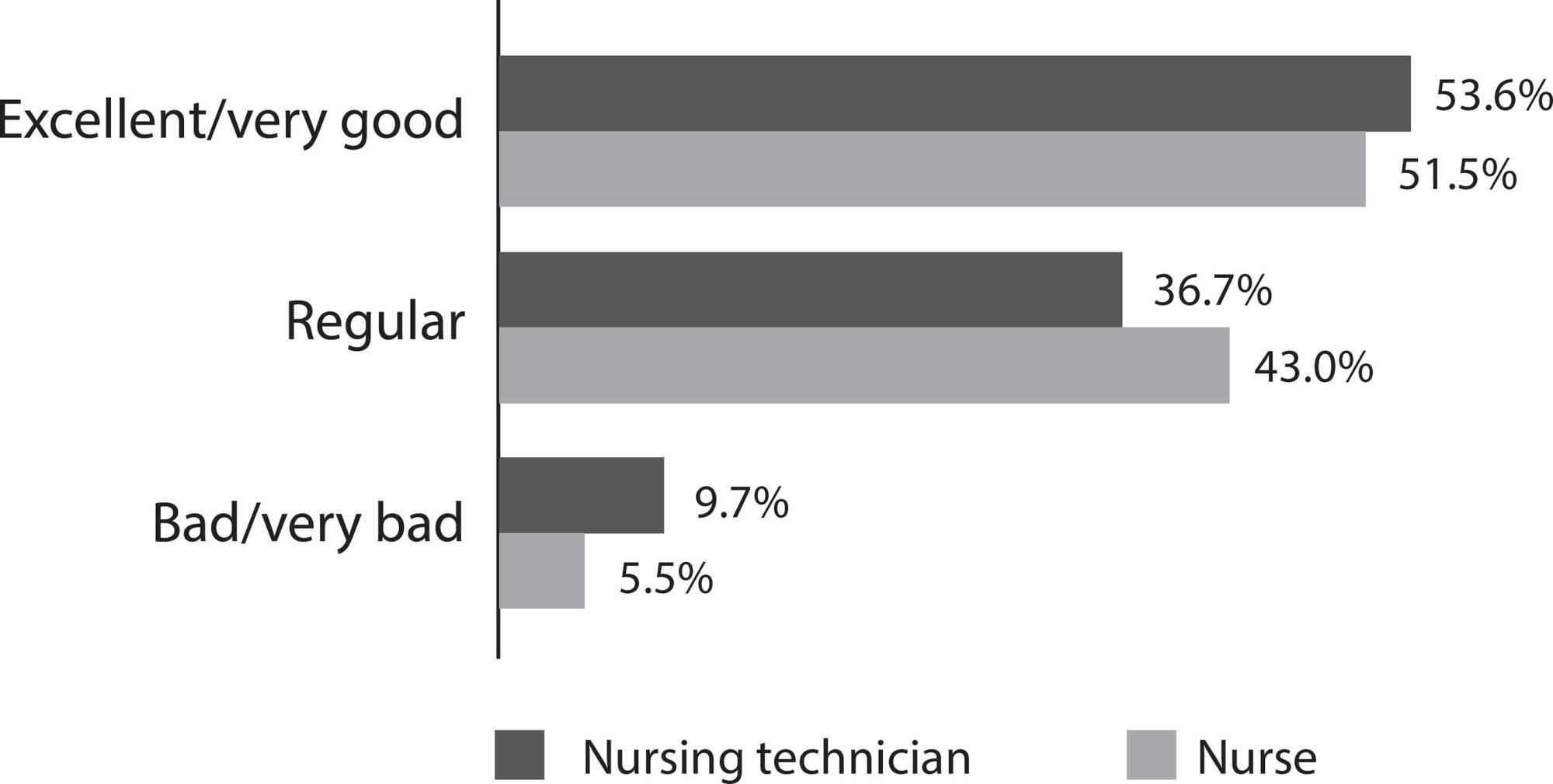
-
ARTÍCULO DE REVISIÓN06/11/2020
Cuidado transicional aos cuidadores de idosos dependentes: revisão integrativa da literatura
Revista Brasileira de Enfermagem. 2020;73:e20200394
Resumen
ARTÍCULO DE REVISIÓNCuidado transicional aos cuidadores de idosos dependentes: revisão integrativa da literatura
Revista Brasileira de Enfermagem. 2020;73:e20200394
DOI 10.1590/0034-7167-2020-0394
Visualizações0Ver maisRESUMO
Objetivo:
Identificar as necessidades dos cuidadores de idosos dependentes para o autocuidado na transição do hospital para casa.
Métodos:
Revisão integrativa que seguiu um protocolo pré-definido, realizada de março a maio de 2019, nas plataformas EBSCO, B-On, Scopus, Web of Science e Joanna Briggs Institute. Foram definidos descritores e critérios de elegibilidade para a amostra bibliográfica, que ficou constituída por dez artigos. Pela atualidade da evidência, limitou-se a pesquisa aos anos de 2015 a 2019.
Resultados:
As necessidades de cuidados transicionais para os cuidadores agrupam-se em cinco categorias: necessidades na transição para o papel de cuidador, necessidades de autocuidado dele próprio, necessidades de saúde, necessidades econômicas e necessidades sociais e comunitárias.
Considerações finais:
O cuidado transicional para os cuidadores deve ter dois focos de atenção, por parte dos enfermeiros: a gestão dos cuidados ao familiar dependente e a gestão das necessidades e dos cuidados ao próprio cuidador.
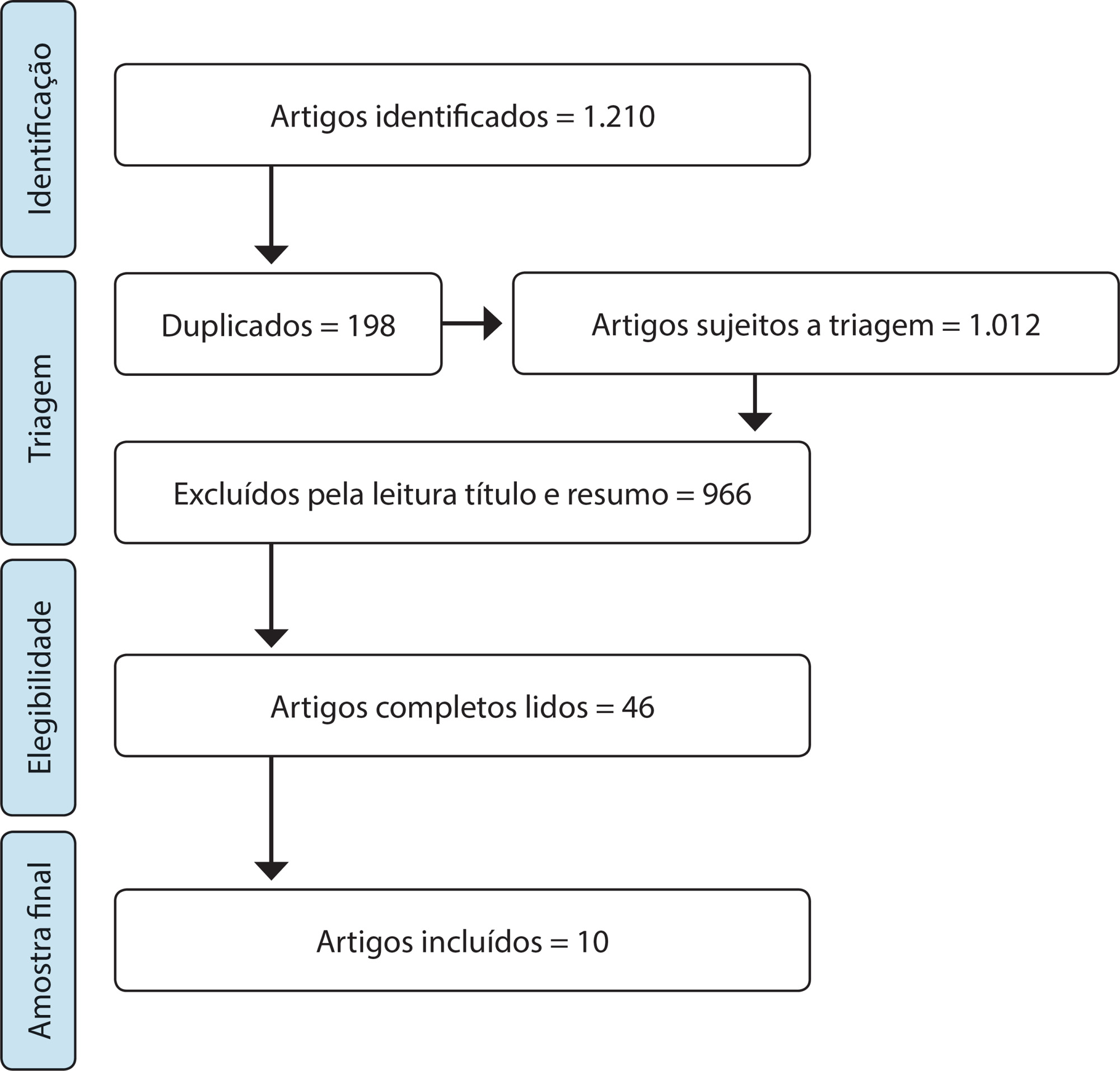
-
ARTÍCULO ORIGINAL24/05/2021
PEDCARE: validação de um aplicativo móvel sobre o autocuidado com o pé diabético
Revista Brasileira de Enfermagem. 2021;74:e20200856
Resumen
ARTÍCULO ORIGINALPEDCARE: validação de um aplicativo móvel sobre o autocuidado com o pé diabético
Revista Brasileira de Enfermagem. 2021;74:e20200856
DOI 10.1590/0034-7167-2020-0856
Visualizações0RESUMO
Objetivo:
descrever o processo de validação de aplicativo multimídia em plataforma móvel para a promoção de cuidado com os pés de pessoas com diabetes.
Método:
estudo de produção tecnológica, do tipo metodológico. O conteúdo e a aparência foram validados por 39 juízes (29 juízes na área de enfermagem e dez com experiência profissional em tecnologia da informação e comunicação e 15 pessoas do público-alvo).
Resultados:
os juízes na área de enfermagem possibilitaram a validação do material com Índice de Validade do Conteúdo total de 0,95, teste binomial não significativo para maioria dos itens e alfa de Cronbach de 0,92, juízes da área de tecnologia da informação e comunicação com Suitability Assessment of Materials de 99,2% e o público-alvo com Índice de Concordância de 98%.
Conclusão:
o aplicativo mostrou-se válido e confiável para uso na prática clínica como tecnologia educacional para promoção de cuidados com os pés de pessoas com diabetes.
Palavras-chave: Aplicativos MóveisDiabetes MellitusEducação em SaúdeEstudos de ValidaçãoPé DiabéticoVer mais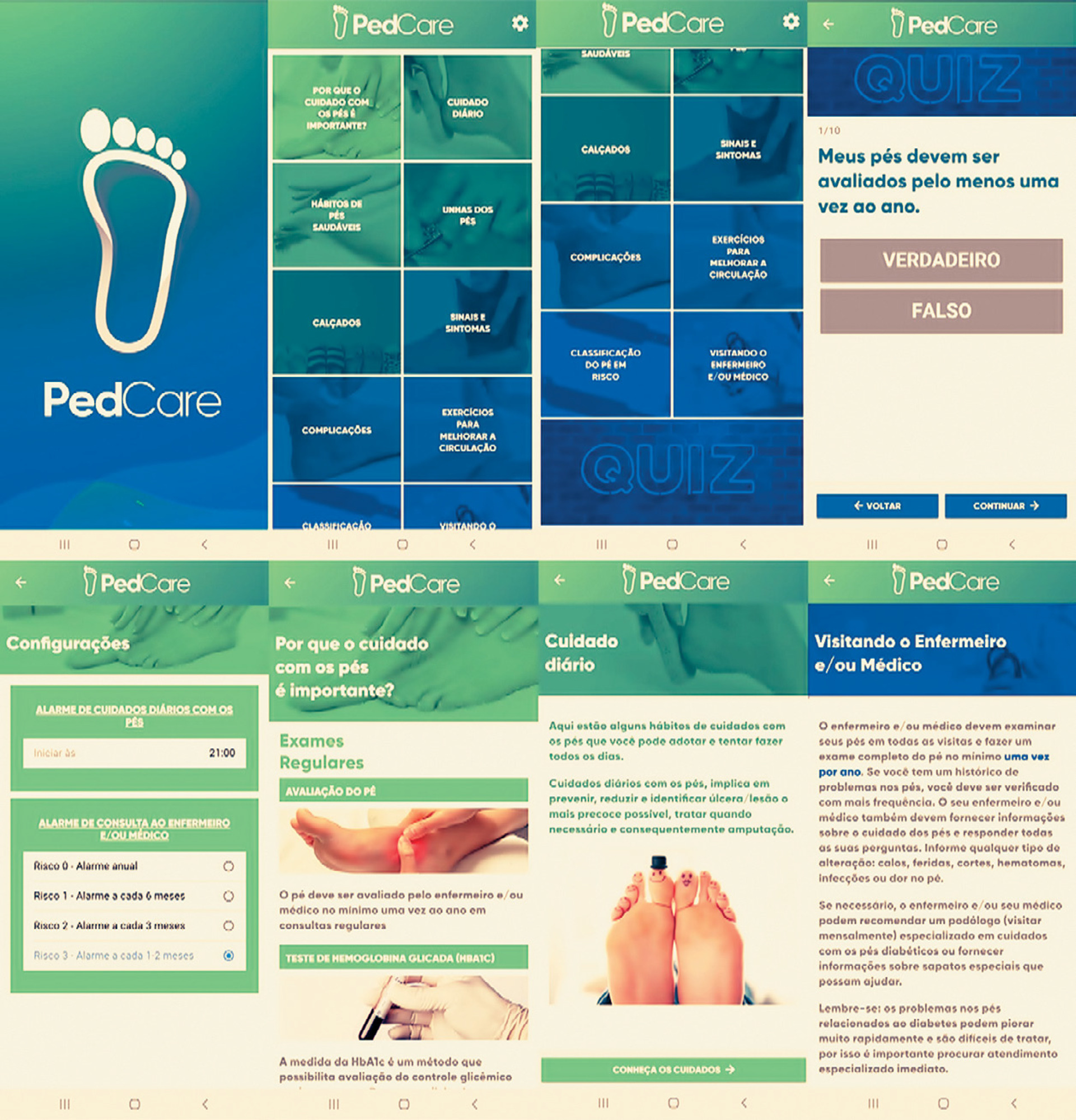
-
INFORME DE EXPERIENCIA09/04/2020
Implantação de algoritmo de inteligência artificial para detecção da sepse
Revista Brasileira de Enfermagem. 2020;73(3):e20180421
Resumen
INFORME DE EXPERIENCIAImplantação de algoritmo de inteligência artificial para detecção da sepse
Revista Brasileira de Enfermagem. 2020;73(3):e20180421
DOI 10.1590/0034-7167-2018-0421
Visualizações0RESUMO
Objetivos:
apresentar a experiência de enfermeiros com inovações tecnológicas computacionais no apoio à identificação precoce da sepse.
Métodos:
relato de experiência de pré e pós-implantação de algoritmos baseados em inteligência artificial para a prática clínica em um hospital filantrópico, no primeiro semestre de 2018.
Resultados:
descrevem a motivação, para criação e uso do algoritmo, o papel do enfermeiro no desenvolvimento e na implantação dessa tecnologia e os seus efeitos no processo de trabalho da enfermagem.
Considerações Finais:
inovações tecnológicas precisam contribuir para a melhoria das práticas profissionais em saúde. Assim, enfermeiros devem reconhecer seu papel em todas as etapas desse processo, de modo a garantir o cuidado seguro, efetivo, centrado no paciente. No caso apresentado, a participação dos enfermeiros no processo de incorporação tecnológica potencializa a rápida tomada de decisão na identificação precoce da sepse.
Palavras-chave: Fidelidade a DiretrizesInformática em EnfermagemInteligência Artificial SepseTomada de DecisõesVer mais -
ARTÍCULO DE REVISIÓN24/03/2021
Development of clinical competence in nursing in simulation: the perspective of Bloom’s taxonomy
Revista Brasileira de Enfermagem. 2021;74(1):e20200135
Resumen
ARTÍCULO DE REVISIÓNDevelopment of clinical competence in nursing in simulation: the perspective of Bloom’s taxonomy
Revista Brasileira de Enfermagem. 2021;74(1):e20200135
DOI 10.1590/0034-7167-2020-0135
Visualizações0Ver maisABSTRACT
Objectives:
to investigate the scientific evidence on the use of Bloom’s taxonomy for developing competence in nursing professionals and students in clinical simulation.
Methods:
integrative review of the National Library of Medicine (NLM), National Institutes of Health (NIH), Cumulative Index to Nursing and Allied Health Literature (CINAHL), Latin American and Caribbean Literature in Health Sciences (LILACS), Web of Science and SCOPUS databases, using the Rayyan application.
Results:
a total of 871 studies were identified; four composed the sample. The development of clinical competence occurred through the coordination of knowledge, skills, and attitudes. To develop the cognitive domain, the objectives of knowledge and comprehension of the Bloom’s taxonomy were mobilized. The psychomotor domain required development of the skills demanded by the proposed clinical care. The affective domain was developed through will and motivation to learn.
Conclusions:
it is possible to develop clinical competence in nursing by adopting Bloom’s taxonomy in each phase of clinical simulation.
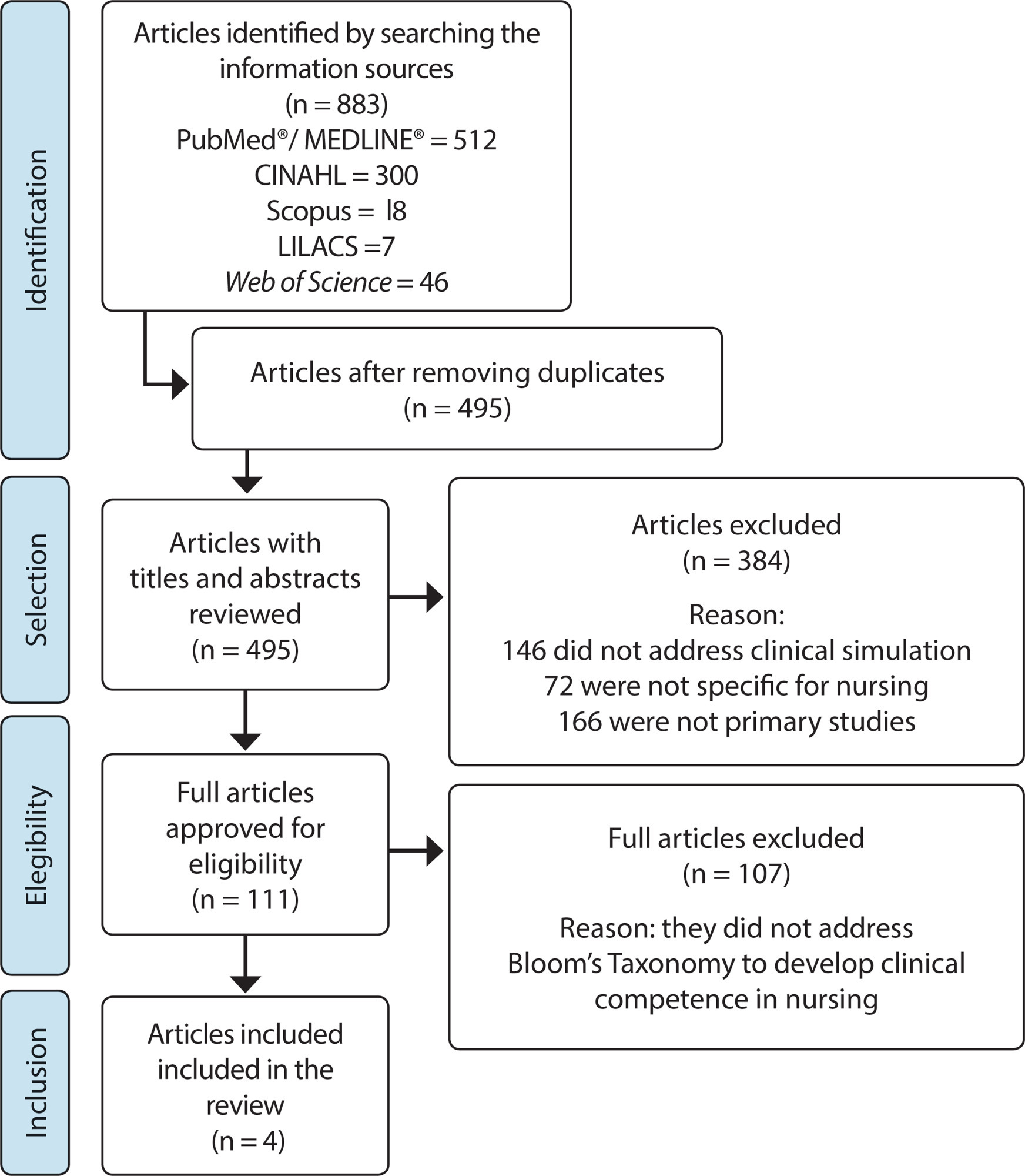
-
27/03/2020
Coronavirus 2020
Revista Brasileira de Enfermagem. 2020;73(2):e2020n2
Resumen
Coronavirus 2020
Revista Brasileira de Enfermagem. 2020;73(2):e2020n2
DOI 10.1590/0034-7167-2020730201
Visualizações0Las enfermedades infecciosas emergentes y reemergentes son desafíos constantes para la salud pública en todo el mundo. Los casos recientes de neumonía de causa desconocida en Wuhan, China, han llevado al descubrimiento de un nuevo tipo de Coronavirus (2019-nCoV), que son virus de RNA envueltos, comúnmente encontrados en humanos, otros mamíferos y aves, capaces de […]Ver mais -
ARTÍCULO ORIGINAL04/12/2020
Lesão por pressão relacionada ao uso de equipamentos de proteção individual na pandemia da COVID-19
Revista Brasileira de Enfermagem. 2020;73:e20200670
Resumen
ARTÍCULO ORIGINALLesão por pressão relacionada ao uso de equipamentos de proteção individual na pandemia da COVID-19
Revista Brasileira de Enfermagem. 2020;73:e20200670
DOI 10.1590/0034-7167-2020-0670
Visualizações0RESUMO
Objetivo:
Descrever prevalência e fatores associados da lesão por pressão relacionada ao uso de equipamentos de proteção individual durante a pandemia da COVID-19.
Métodos:
Estudo transversal realizado por meio de instrumento disponibilizado em redes sociais com 1.106 profissionais de saúde. Os dados foram analisados por meio de estatística descritiva e comparada, considerando valor de p < 0,05.
Resultados:
Houve prevalência de 69,4% para lesão por pressão relacionada ao uso do equipamento de proteção individual, com uma média de 2,4 lesões por profissional. Os fatores significativos foram: menores de 35 anos de idade, trabalhar e fazer uso de equipamentos de proteção individual por mais de seis horas no dia, em unidades hospitalares e sem o uso de insumos para proteção.
Conclusão:
A lesão por pressão relacionada ao uso de dispositivos médicos apresentou alta prevalência nessa população. O reconhecimento da lesão nesses profissionais possibilita avançar em estratégias de prevenção.
Palavras-chave: CoronavírusEquipamento de Proteção IndividualLesão por PressãoPandemiasPessoal de SaúdeVer mais
Búsqueda
Buscar en:
Nuvem de Tags
Adolescente (85) Atenção Primária à Saúde (239) COVID-19 (91) Criança (91) Cuidados de Enfermagem (269) Educação em Enfermagem (151) Educação em Saúde (139) Enfermagem (930) Enfermagem Pediátrica (86) Estudantes de Enfermagem (77) Estudos de Validação (131) Família (87) Idoso (208) Promoção da Saúde (99) Qualidade de Vida (104) Saúde do Trabalhador (86) Saúde Mental (145) Saúde Pública (82) Segurança do Paciente (150) Tecnologia Educacional (100)



